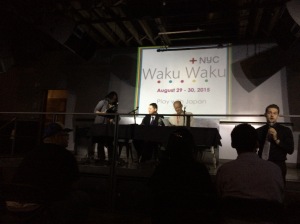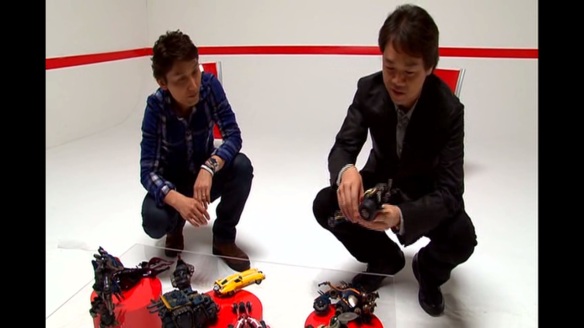(yes, there are spoilers for Boruto here; mainly for describing who was responsible for which action scene)
I watched Boruto earlier today. I haven’t had such a strong positive reaction to a movie in a long time. Unlike the fans in Japan, I have only just read the last Naruto chapter last week, as opposed to a year before this movie debuted. Thus, I haven’t had a lot of time to step away from the series. On top of that, I got to see Kishimoto in person last week (twice!) at the Apple Store event in SoHo, NYC and at NYCC. Kishimoto was a very humble man. He was visibly nervous when he began to talk to his fans at the Apple Store (his first public event in the United States), but he eased into the moment and opened himself up a bit. You can view the entire event at the Apple Store’s Meet the Author podcast. During the NYCC panel, the Boruto trailer was screened. The audience went crazy and Kishimoto was very moved. He remarked that he was almost about to cry. It was a very touching moment I’m glad I got to be a part of.
In any event, Boruto was amazing. The opening fight scene was animated by Naoki Kobayashi. He emerged as an animator on Shippuden while he was under contract at Pierrot. He most recently appeared on One-Punch Man, so I’m not entirely clear if he’s still under contract at Pierrot. In any event, he’s already been responsible a lot of great work for the series. The opening scene was a bit hard to follow in terms of the storyboarding, but my experience was probably hindered because people were walking by me and blocking my view as the movie started.
The scene where Momoshiki arrived and blew away the Chunin Exam arena looked to be Hidetsugu Ito’s work. After that, Tetsuya Nishio, Ito’s childhood friend, was likely responsible for the scene where Momoshiki is laughing at Naruto and Sasuke as he readies his attack. Shinji Hashimoto did the crazy scene right after where Naruto in Kurama Mode tries to hold off the huge attack from Momoshiki, which destroys a huge part of the Village. In the final climax, Arifumi Imai (of Attack on Titan fame) was responsible for the scene where the Kyubi/Susanoo combo samurai-chopped Momoshiki’s giant in half. Hiroyuki Yamashita seemed like he did the final Rasengan (note: Naoki Kobayashi also animated the final Rasengan).
I’ll be honest. I had trouble paying attention during the final climax of the movie, because I was literally crying during Norio Matsumoto’s work (the two young women next to me also lost it at this point, so not only the hardcore sakuga fans react this way). He handled the Sasuke and Naruto vs. Momoshiki taijutsu scene. It’s impossible to miss. It also seemed like he animated part of the Gokage’s fight against Momoshiki’s henchman as well. The taijutsu fight was Matsumoto at his best–only highly condensed for full effect. What really drove the taijutsu scene home for me was that it was set to a specific track I had for years hoped would be used in conjunction with Matsumoto-animated scene. It was a dream come true.
Matsumoto is among the staff credited with storyboarding/unit directing/animation directing part of the movie, so it’s almost certain that he was responsible for most, if not all, of the entire climax of the movie. The moving backgrounds during this final act hark back to Matsumoto’s work with Atsushi Wakabayashi (e.g., Naruto episode 30 and 71). You can find clips of Matsumoto’s work here online, but if you’re a fan of Naruto you owe it to yourself to watch the scene in context (preferably in the theater if you still can). It is much more emotionally satisfying that way.
The ending sequence was directed and animated by Toshiyuki Tsuru (working under his Yasuaki Kurotsu pen name) was simple, but effective. He drew the characters using the manga’s style (including using hashmarks for shading purposes) similar to what he did for Shippuden ED 2 with Hirofumi Suzuki. I’m still holding hope Tsuru and Suzuki will work on the TV series again once last time.
As for the movie itself, I can see why Kishimoto said last week at NYCC that Boruto was the last chapter in the Naruto story.The story is brought full circle. Naruto himself starts off as a kid who’s shunned by everybody and without a father figure. Now, he’s the Hokage and he doesn’t give his children the attention Naruto himself wanted when he was a child. Thus, this leaves Boruto with the same desire to prove himself. Except, as opposed to wanting to prove himself to everybody in the Village, like Naruto did, Boruto wants his dad to give him some proper time and devotion.
Kishimoto began writing the script right after finishing the serialization of the Naruto manga in WSJ. Kishimoto admitted that he wrote the script from the perspective of being father himself to two children. It’s not hard to see the parallels. Kishimoto is a busy manga artist who can’t spend time with his kids because he has so much work to do and Naruto is in the same situation.
The movie moves along nicely with plenty of callbacks and references to previous iconic imagery from the series. At one point, these moments tended to be a bit too eager to pull at the emotional heartstrings, but by the final climax that complaint briskly fades away. The villains are not particularly memorable, but it’s hard to make a memorable villain after all of the ground the series covered during its 700 chapters. The villains serve as a vehicle for amazing fight scenes and thus serves their purpose well.
Hiroyuki Yamashita at the helm did a great job overall, but I wonder what will be the next step for him once Naruto is done. I’m not sure if he’ll take a more serious tone as a director or simply remain as an action director (which is perfectly fine and I wouldn’t complain!). At this point, I’d bet on the later if he remains at Pierrot.
In all, Boruto is a very fitting conclusion for the series. Potentially down the line they will ask Kishimoto for more material or they’ll come up with some new side-story, but after watching this movie there really is no need for it.




